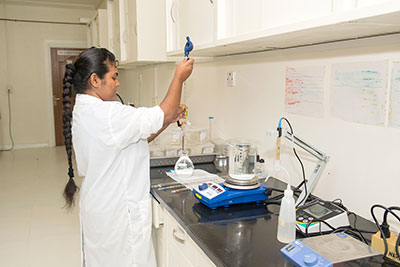– The wonder of Science in agriculture
Daily, research personnel of the National Agricultural Research and Extension Institute (NAREI) garbed in lab coats immerse in the fascinating world of Science. Through trial and error, and sometimes years of experiments, they have had successful breakthroughs, contributing to the development of agriculture.

NAREI’s Biotechnology Laboratory is a restricted area where permission is required before entry. Of course, it is a sterile environment and the many apparatus emphasise that serious scientific work is being done here.
The Research Scientist, Research Assistants and Research Technician who utilize the Biotechnology Laboratory are involved in Plant Tissue Culture, which is a technique used to grow plant cells, tissues, organs or whole plants in laboratory conditions. This method of plant growth is referred to as micro propagation.
Parts of the plants that are used for cultures include young growing tips of plant (shoot tips) buds, nodes and roots. Those plant parts are usually small in size and may vary from less than 1mm to 15mm in length. Some crops currently being investigated by NAREI include pineapple, cassava, sweet potato, and plantain.
The five stages in Plant Tissue Culture
Preparation: In this stage the media, containing requirements for the tissue to grow into plants, is prepared to form the stock solutions. It is imperative that this is one under hygienic conditions.
Initiation: This stage results in the establishment of new plants under laboratory conditions. Laboratory conditions are sterile conditions. This could be achieved three ways: steam, dry heat or chemical.
After sterilization, initiation takes places: the bud or shoot tip is placed in the media and stored under artificial conditions. The light, temperature, and humidity are controlled to mimic that of the outside environment necessary for plant growth. Depending on the type of plant, for example a cassava will grow into a single long plant while a pineapple will grow into a cluster.
Multiplication: At this stage in the process there is an activity called sub-culturing. For example the new cassava shoot that was recently formed in the test tube could be divided into three smaller pieces and placed in fresh media. For the pineapple, the clusters could be separated and placed in fresh media. This process is repeated as needed. Further, this process could be repeated about six to eight times on a monthly basis. That is why this stage is associated with rapid growth.
Rooting: This stage is applicable to those cultures that did not grow roots. After building up a quantity of cultures a different type of media is prepared to induce rooting. Importantly, at this stage a plantlet (cultures) is in the test tube.
Weaning: This stage is divided into two: acclimatization and hardening. The first step is acclimatization: the plantlet is removed from artificial conditions and is placed in green house conditions. Slowly the conditions are changed from artificial to green house to avoid the plantlet from experiencing shock. After surviving the transition, the plantlet is moderately exposed to sunlight. Once the plantlet is hardened it could go to the fields.
NAREI has successfully developed protocols for the production of sweet potato, pineapple, plantain and bananas and cassava. Research continues in other crops such as orchids, coconuts, and breadfruit among others.
The benefits of Plant Tissue Culture include: year-round multiplication of planting material; use of small-sized explants to multiply plants; rapid bulking-up of plant material;more secure storage of plant material (germplasm) compared to traditional method of field storage; and more efficient utilization of space to store large numbers of plant containers.
(Contributed by NAREI)



.jpg)








